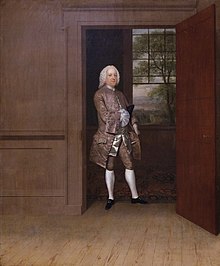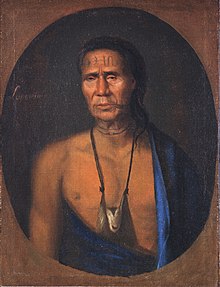|
Walking Purchase The Walking Purchase, also known as the Walking Treaty, was a 1737 agreement between the family of William Penn, the original proprietor of the Province of Pennsylvania, and the Lenape native Indians. In the purchase, the Penn family and proprietors produced a deed to claim that a 1686 treaty with the Lenape ceded an area of 1,200,000 acres (4,860 km2) in present-day Lehigh Valley and Northeastern Pennsylvania in colonial Pennsylvania, which included a western land boundary extending as far west as a man could walk in a day and a half, which led to its name. The area is along the northern reaches of the Delaware River, on Pennsylvania's border with what was called, at the time, West Jersey. Encyclopædia Britannica refers to the treaty as a "land swindle".[1] The Lenape appealed to the Iroquois Indian tribe to their north for aid on the issue, but the Iroquois refused their request, ultimately siding with the Penn interests. Nearly 300 years later, in 2004, a lawsuit was filed over the continuing dispute. In the case, Delaware Nation v. Pennsylvania, the Delaware Tribe, one of three later federally-recognized Lenape tribes, and its descendants in the 21st century claimed 314 acres (1.27 km2) of land included in the original purchase in 1737, but the U.S. District Court granted the Commonwealth's motion to dismiss. It ruled that the case was nonjusticiable, even if the Delaware Nation's allegations of fraud were factually accurate. This ruling was upheld through several appeals in the United States courts of appeals, which culminated in the U.S. Supreme Court refusing to hear the case, thereby upholding the lower courts' decision. History17th century   In 1681, the founder of the Province of Pennsylvania, William Penn, enjoyed a reputation for fair dealing with the Lenape.[2] However, William Penn's two sons, John and Thomas, largely abandoned their father's moderate practices. 18th centuryIn 1736, they claimed a deed from 1686 under which the Lenape promised to sell a tract beginning at the junction of the upper Delaware River and the tributary Lehigh River, near present-day Easton, Pennsylvania in the Lehigh Valley and extending as far west as a man could walk in a day and a half. The agreement later became known as the "Walking Purchase" or the Walking Treaty of 1737. The original 17th century document might have been a verbal agreement, an unsigned treaty, an unratified treaty, or an outright forgery. The Penns' agents, however, began selling land in the region in and around present-day Lehigh Valley along the Lehigh River prior to the Lenape vacating the still inhabited area. To address the Lenape's misgivings and suspicions, Penn Land Office Agent and provincial secretary James Logan produced a map that misrepresented the farther Lehigh River as the closer Tohickon Creek, and including a dotted line showing a seemingly reasonable path that the walkers would take. Satisfied that the land in question was not so terrible a price to honor the old deed, the Lenape signed on, making the now 1737 treaty official.[2] According to the popular account, Lenape leaders assumed that about 40 miles (60 km) was the longest distance that could be covered under these conditions. Provincial Secretary Logan hired the three fastest runners in the colony, Edward Marshall, Solomon Jennings, and James Yeates, to run on a prepared trail. They were supervised during the walk by Timothy Smith, then sheriff of Bucks County, Pennsylvania. The walk occurred on September 19, 1737; only Marshall finished,[2] reaching the modern vicinity of present-day Jim Thorpe, Pennsylvania, 70 miles (113 km) to the north. At the end of the walk, Sheriff Smith drew a perpendicular line back toward the northeast, and claimed all the land east of these two lines ending at the Delaware River that now represents the border between eastern Pennsylvania and western New Jersey. This resulted in an area of 1,200,932 acres (4,860 km2), only slightly smaller than the size of Rhode Island, located in seven present-day counties in eastern Pennsylvania: Pike, Monroe, Carbon, Schuylkill, Northampton, Lehigh, and Bucks. The Delaware Tribe leaders appealed for assistance to the Iroquois confederacy tribe to the north, who claimed hegemony over the Delaware River, but the Iroquois leaders decided that it was not in their best interest to intervene on behalf of their southern neighbors since Iroquois leader Captain Logan already made a deal with the Iroquois to support the colonial side. As a result, the Lenape vacated the Walking Purchase lands in present-day eastern Pennsylvania and western New Jersey. Lenape chiefs Lappawinsoe, Manawkyhickon, Sassoonan, Nenatcheehunt, and others continued protesting the arrangement, since the Lenape were forced into Shamokin and Wyoming River valleys, which were already crowded with other displaced tribes. Some Lenape later moved further west into the Ohio Country in present-day Western Pennsylvania and Ohio, and to southern and western regions in colonial New France in present-day Quebec. Because of the Walking Purchase, the Lenape grew to distrust the Pennsylvania government, and later brought suit in federal court. Delaware Nation v. PennsylvaniaEastern District federal court (2004)In 2004, Delaware Nation, representing the Lenape, filed suit against the Commonwealth of Pennsylvania in the U.S. District Court for the Eastern District of Pennsylvania in Philadelphia, seeking 314 acres (1.27 km2) included in the 1737 Walking Purchase and patented in 1741, which was known as Tatamy's Place. The court granted the Commonwealth's motion to dismiss.[3] According to the federal Eastern District Court:
The District Court recounted the Delaware Nation's allegations:
The Delaware Tribe conceded that Thomas Penn had "sovereign authority," but challenged the transaction on the ground that it was fraudulent.[3] The court held that the justness of the extinguishment of aboriginal title is nonjusticiable, including in the case of fraud.[3] Because the extinguishment occurred prior to the passage of the first Indian Nonintercourse Act in 1790, that Act did not avail the Delaware.[3] Federal appellate courts (2006)In 2006, Delaware Nation's appeal of the decision was heard in the United States Court of Appeals for the Third Circuit in Philadelphia, which upheld the earlier ruling of the District Court.[4] The Third Circuit upheld that aboriginal title may validly be extinguished by fraud, and further held that the tribe had waived the issue of whether Penn was actually a sovereign purchaser.[4] Moreover, the Circuit held that any grants to the tribe subsequent to the extinguishment could not re-establish aboriginal title.[4] Therefore, the Circuit did not consider the merits of the tribe's argument that:
The Circuit Court found it insufficient that the complaint alleged that Penn was "accountable directly to the King of England."[4] Delaware Nation filed for the case to be heard by the U.S. Supreme Court, which declined to hear the case on appeal, upholding the prior rulings by the two federal courts in Philadelphia.[5] See alsoReferences
External linksWikimedia Commons has media related to Walking Purchase.
|